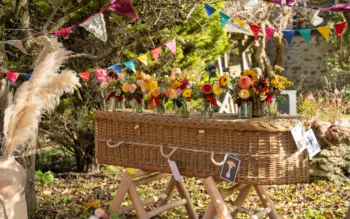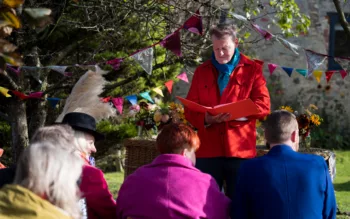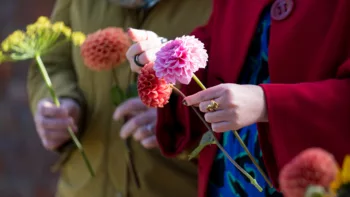Planning a funeral can be one of life’s most emotional challenges, but it’s also an opportunity to celebrate a life in a way that reflects the individual’s unique personality, values, and the relationships they made in life.
Increasingly, families in the UK are moving away from traditional religious and prescriptive ceremonies and opting for personal ceremonies that celebrate a life lived, tailored to their loved one. According to the recent SunLife Cost of Dying Report, 69% of funeral directors say they’ve seen a drop in the number of traditional religious funerals – 13% more than the year before.
If you’re planning a non-religious funeral or memorial and you would like it to honour the person who has died, here are some tips to help you create a truly personal funeral ceremony.
1. Choose a Meaningful Location for a Memorial or Funeral

Funerals don’t have to take place in traditional venues, such as a cemetery or crematorium chapel. Instead, think about locations that held special significance to your loved one.
Many venues will host a funeral ceremony with a coffin present, including hotels, pub rooms, community halls, or country houses. Or you could have a ceremony in an outside space, such as a private garden, in a woodland, or on a secluded beach. In all cases, you’ll need to check with the owner’s of the property or the land to make sure they give permission.
If you are planning a memorial or ash ceremony after a direct cremation, there are even more options, and you can choose a place to gather and remember your loved one that totally resonates for them.
You do need to ask the landowner’s permission to scatter or inter ashes.
2. Work with a Humanist Funeral Celebrant
If your loved one wasn’t a religious person, a non-religious funeral led by a humanist celebrant could be the perfect way to celebrate their life. Humanist Ceremonies celebrants are highly trained to create ceremonies that focus on the individual, their achievements, relationships, and the impact they had on others.
They work closely with the family, meeting with them to learn more about the person who has died, crafting a bespoke ceremony script that incorporates personal stories and includes any rituals that resonate with the family’s values.

3. Incorporate Personal Elements from the Person’s Life
Personalising a funeral often comes down to the small touches, such as including items that reflect the person’s hobbies, passions, or character. For example:
- Display favourite photographs or create a memory board. You can create a photo slideshow or work with Obitus, who will create a slideshow set to music.
- Use decorations in your loved one’s favourite colour. or one that matches a sports team they supported. You could also ask attendees to wear something in that colour – funerals don’t have to mean black!
- Include mementoes such as sports memorabilia, art they created, tools they used, or books they loved.
4. Customise Music and Readings
Music and readings at a funeral can evoke powerful emotions and memories, making them an essential part of a personal ceremony.
- Choose songs or pieces of music that the person loved, or that hold special meaning for the family.
- Ask close friends or family members to share readings, poems, or letters that reflect the person’s personality and life.
Poems and readings don’t have to be sad, here are some choices for uplifting poems to use at a humanist funeral.

5. Create a Lasting Symbolic Tribute
Consider including a symbolic act that will leave a lasting tribute, such as:
- Planting a tree in their memory.
- Creating a memory jar where attendees can leave written thoughts, memories, or wishes.
- Organising a collection in their name to support a cause they cared about.
- Providing attendees with a small keepsake, like a photo card or a packet of seeds to plant in their memory.
- If your loved one is having a Humanist Ceremonies funeral you can also add their story to the Funeral Tribute Archive – A historical collection of humanist funeral tributes.
6. Create a Memorial with Ashes
For families choosing cremation, ashes can be used to create a lasting tribute in unique and meaningful ways. This can take place after a funeral or after a direct cremation.
You can also work with a celebrant to create a humanist ash-scattering ceremony.
Some options for ashes include:
- Scattering ashes in a location that held special significance to the person.
- Having a portion of the ashes made into jewellery or keepsakes for close family members.
- Incorporating the ashes into artwork, such as glass sculptures or paintings.
- Have the ashes sent into space – read our blog with Aura Flights who provide this service.
For more ideas, here is our guide to scattering ashes.
A Growing Trend Toward Personalisation
 The rise in personalised funerals reflects a broader shift in how we approach end-of-life ceremonies. The SunLife Cost of Dying Report 2025 found that families increasingly value individuality in these moments, with personal touches helping to create a sense of closure and connection. By planning a personal funeral ceremony, you can ensure that your loved one’s unique life is honoured in a way that brings comfort to everyone involved.
The rise in personalised funerals reflects a broader shift in how we approach end-of-life ceremonies. The SunLife Cost of Dying Report 2025 found that families increasingly value individuality in these moments, with personal touches helping to create a sense of closure and connection. By planning a personal funeral ceremony, you can ensure that your loved one’s unique life is honoured in a way that brings comfort to everyone involved.
There’s no right or wrong way to plan a funeral. The key is to focus on what truly honours the individual’s life and legacy. Whether it’s through music, stories about their life, or the location itself, personalising a funeral ensures that the ceremony is as unique as the person you are celebrating. If you’re planning a non-religious funeral, working with a Humanists UK celebrant can provide support and guidance in creating an authentic and meaningful ceremony.





